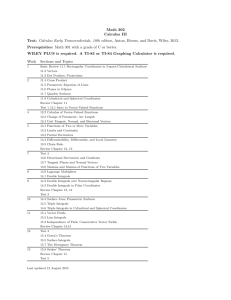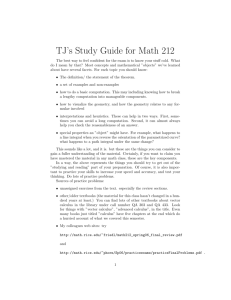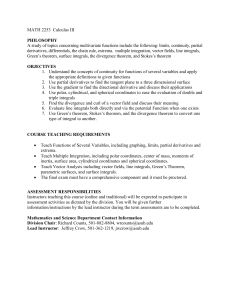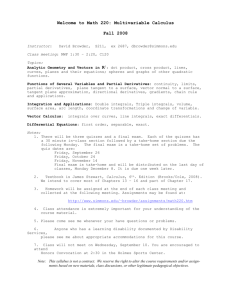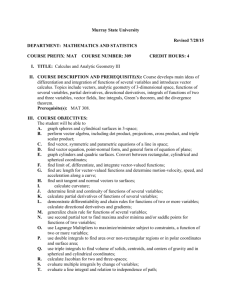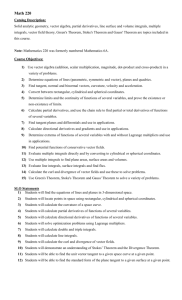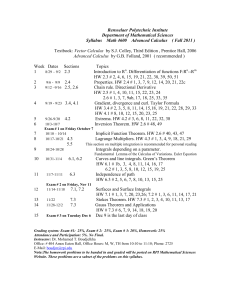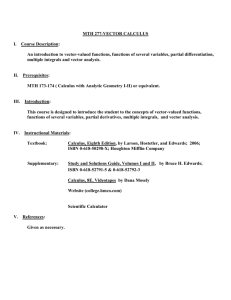MAT 238 CALCULUS III MASTER SYLLABUS
advertisement
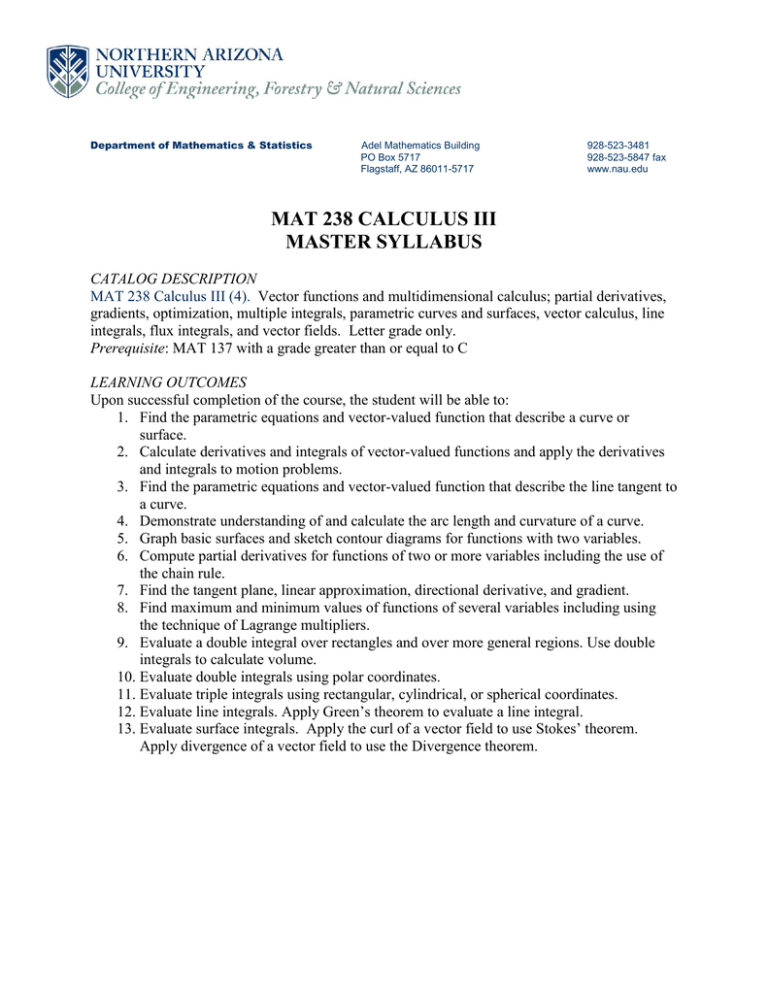
Department of Mathematics & Statistics Adel Mathematics Building PO Box 5717 Flagstaff, AZ 86011-5717 928-523-3481 928-523-5847 fax www.nau.edu MAT 238 CALCULUS III MASTER SYLLABUS CATALOG DESCRIPTION MAT 238 Calculus III (4). Vector functions and multidimensional calculus; partial derivatives, gradients, optimization, multiple integrals, parametric curves and surfaces, vector calculus, line integrals, flux integrals, and vector fields. Letter grade only. Prerequisite: MAT 137 with a grade greater than or equal to C LEARNING OUTCOMES Upon successful completion of the course, the student will be able to: 1. Find the parametric equations and vector-valued function that describe a curve or surface. 2. Calculate derivatives and integrals of vector-valued functions and apply the derivatives and integrals to motion problems. 3. Find the parametric equations and vector-valued function that describe the line tangent to a curve. 4. Demonstrate understanding of and calculate the arc length and curvature of a curve. 5. Graph basic surfaces and sketch contour diagrams for functions with two variables. 6. Compute partial derivatives for functions of two or more variables including the use of the chain rule. 7. Find the tangent plane, linear approximation, directional derivative, and gradient. 8. Find maximum and minimum values of functions of several variables including using the technique of Lagrange multipliers. 9. Evaluate a double integral over rectangles and over more general regions. Use double integrals to calculate volume. 10. Evaluate double integrals using polar coordinates. 11. Evaluate triple integrals using rectangular, cylindrical, or spherical coordinates. 12. Evaluate line integrals. Apply Green’s theorem to evaluate a line integral. 13. Evaluate surface integrals. Apply the curl of a vector field to use Stokes’ theorem. Apply divergence of a vector field to use the Divergence theorem. Page 2 COURSE CONTENT 1. Vector functions: 6-8 days Vector review. Parametric curves, vector functions, velocity and acceleration, arc length and curvature, parametric surfaces. 2. Partial derivatives: 12-14 days Surfaces, functions of two or more variables, contour diagrams, partial derivatives, tangent plane, linear approximation, chain rule, directional derivative, gradient vector, maximum and minimum values, method of Lagrange multipliers. 3. Multiple integrals: 15-17 days Double integrals, iterated integrals over rectangles and over more general regions, surface area, double integrals in polar coordinates, general change-of-variables theorem for double integrals, triple integrals in rectangular, cylindrical, and spherical coordinates; 4. Vector calculus: 18-20 days Vector fields, line integrals, conservative vector fields, fundamental theorem for line integrals, Green's theorem, curl and divergence, parametric surfaces, surface integrals, Stokes’ theorem, divergence theorem. If time permits other topics include: tangential and normal components of acceleration, Kepler’s law of planetary motion, multivariable higher order Taylor approximations, or partial differential equations. STRUCTURE AND APPROACH The course will use any or all of: lecture, discussion, student presentations, in-class work, or group work. In addition students may use technology (e.g. Mathematica, or graphing calculators). ASSESSMENT The assessment procedures include: at least three, preferably four mid-term exams; a comprehensive final exam (minimum 20%); and some selection of (a) homework assignments (WebWork or other), (b) in-class work, and (c) quizzes. CURRENT AND RECENT TEXTS 1. Whitman Online Text: http://www.whitman.edu/mathematics/multivariable/ 2. Paul’s Online Math Notes: http://tutorial.math.lamar.edu/Classes/CalcIII/CalcIII.aspx 3. Stewart: Calculus – Concepts and Contexts Revised May 2012; Effective Fall 2012
